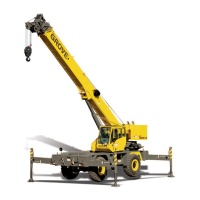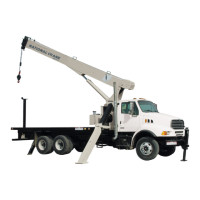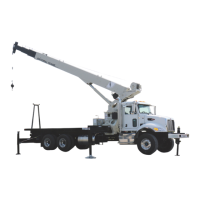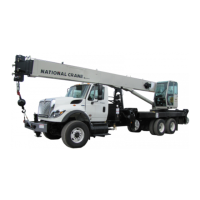14000 SERIES 2
Luffing Jib Raising Procedure
Fixed Jib No. 138 on Luffing Jib No. 135 on Boom No. 76
Manitowoc Cranes, Inc.
8799-B, 2011-09-23
Manitowoc, Wisconsin 54220 U.S.A.
1/4
Recommended boom, luffing jib and fixed jib raising and lowering procedure:
14000 SERIES 2 must be equipped with 168,000 lb (76 200 kg) crane counterweight and 53,000 lb (24 040 kg)
carbody counterweight. Refer to fixed jib rigging assembly No. 179361 for makeup of inserts, pendants, strut, jib
stop setup and operation, and miscellaneous parts, etc. Refer to luffing jib rigging assembly No. A18387 for boom
and luffing jib make-up of inserts, pendants, struts, strut raising and lowering procedure, jib stop setup and
operation and miscellaneous parts, etc. Refer to Operator’s Manual for setup and installation.
Three methods may be used to raise and lower boom, luffing jib and fixed jib combinations, depending on
length:
A. Layout Jack-Knife Method With Fixed Jib Attached:
Caution: Anytime luffing jib or fixed jib point rollers are in contact with ground during raising or lowering
procedure, disengage swing lock and release swing brake.
Raising:
Boom, luffing jib and fixed jib are assembled in layout, end-to-end, position. Raise fixed jib strut and attach
pendants and backstays. Attach fixed jib stop to fixed jib butt and temporarily tie off to fixed jib strut. Slowly
raise boom until luffing jib stop strut is just clear of ground. Attach luffing jib stop pendants and unpin luffing jib
stop inner strut from retracted position. Slowly raise boom until luffing jib stop strut is fully extended and pins
engaged (approximately 168 degree boom-to-luffing jib angle). Boom is then raised while luffing jib point and
fixed jib point wheels are allowed to roll on ground. Tension should be applied to luffing jib hoist to keep luffing
jib strut off luffing jib during boom raising. Boom up until boom-to-luffing jib angle reaches value specified in the
tables. Tighten luffing jib suspension with luffing jib hoist. Boom and luffing jib are then raised together using
boom hoist while fixed jib point wheel rolls on ground. Continue raising until fixed jib suspension tightens.
Attach fixed jib stop to luffing jib top. Boom, luffing jib and fixed jib are then raised together using boom hoist
until boom reaches desired boom operating angle. Fixed jib radius must be within capacity chart before
swinging over side of machine when raising over end of blocked crawlers.
Lowering:
Position boom at 85 degrees prior to lowering luffing jib. Lower luffing jib until boom-to-luffing jib angle reaches
value specified in the tables. Lower boom until fixed jib point wheels contact ground. Remove fixed jib stop from
luffing jib top and temporarily tie off to fixed jib strut. Lower boom as fixed jib point wheels roll on ground. Lower
boom until luffing jib point wheels contact ground. Continue to lower boom while luffing jib and fixed jib point
wheels roll along ground. Keep enough tension on luffing jib hoist to keep luffing jib strut off luffing jib. Stop
lowering boom when luffing jib stop pendants start to go into tension (approximately 168 degree boom-to-luffing
jib angle). Disengage luffing jib stop strut pins and lower boom to retract luffing jib stop inner strut. Pin strut in
retracted position.













